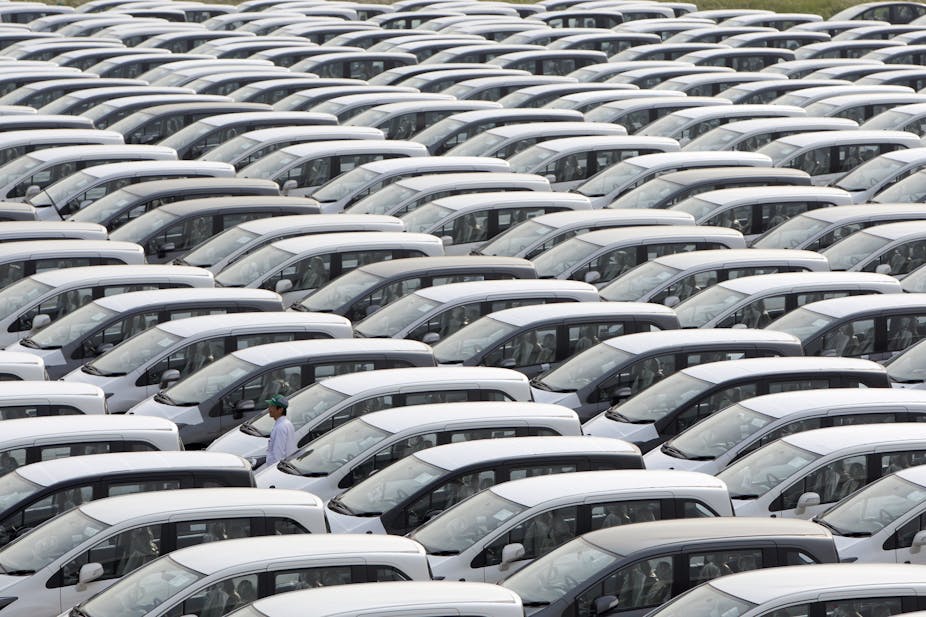Now that the final nail has been hammered in to the car industry’s coffin, what does it mean for the Australian economy?
As always, the data is a good place to start.
Efficient manufacturing depends largely on scale - production of cars in Australia has fallen from 324,118 in 2008 to 210,538 in 2013. That 2013 number represents less than 20% of the 1,136,227 cars purchased by Australians in that year. None of the top four selling cars in 2013 - in order: Toyota Corolla, Mazda, Toyota HiLux and Hyundai i30 - are made in Australia.
What about employment? In 2012, 51,931 workers were employed in the entire automotive industry, a decline from 77,776 in 2003. Only 11,053 of those in 2012 were directly employed in car manufacturing. The latter is about 1.2% of the total manufacturing workforce of about 960,000.
In 2013, the monthly fluctuations, up or down, in full time persons employed in Australia averaged 5,600. That’s half the entire car manufacturing workforce. So a loss of car manufacturing employment would be a blip in terms of the national employment numbers.
At the same time profitability has been tanking. The local manufacturing sector made a trading loss of A$670 million in 2012, compared with a profit of $313 million in 2003. Despite declining employment, declining profitability and virtually zero productivity growth over 10 years, total wages and salaries paid by the industry have increased every year – by 2.8% in 2012 for example total government (read taxpayer) assistance to the car manufacturing industry was valued by the Productivity Commission at over A$1 billion in 2012, more than half of which was subsidies in the form of cash and special tax concessions, the remainder being the value of tariff assistance. The annual cash subsidies have been fairly steady over the past 10 years although the tariff assistance has declined. This rate of assistance is more than twice as high as the average received by other manufacturing industries.
In short, this has for many years been a manufacturing industry in steady decline, losing sales and shedding jobs, making losses, yet receiving taxpayer assistance way in excess of other industries.
Why is car manufacturing special?
The idea that car manufacturing is unique and deserves special taxpayer aid because it is a laboratory for core skill development, or because it is part of a long supply chain linking thousands of jobs, is highly exaggerated at best. The same arguments could be applied to just about any industry such as tourism, higher education or health. They all invest in skill formation and are linked to a long supply chain.
Another overblown claim is that the car manufacturing regions in South Australia and Victoria would be crippled by the loss of jobs as the multiplier effects of lost spending by workers ripple through the local communities. Research suggests that ultimately up to 13,000 workers could lose jobs, directly and indirectly, from the closure of a single GM plant in Elizabeth in South Australia. However this looks like an absolute worst case scenario.
The recent industry announcements are not like the closure of Mitsubishi’s plant in Tonsley Park South Australia, where the decision was announced in February 2008 and the factory closed its doors the next month. The workers of Holden and Toyota have nearly four years to plan their futures. These workers have skill and experience. Some will find other full time jobs in manufacturing, some will change careers perhaps going into small business, some will work part-time and some will probably retire. And they will receive good redundancy pay. We can’t just assume that all of their labour and all of their spending will be completely lost.

Where tax dollars go
Jobs across the country will also be supported by the saving to taxpayers of the hundreds of millions of dollars that have been pumped into car manufacturing every year. Governments can spend the money on health, education, or paying off debt – yesterday’s spending that was unfunded – which in turn means lower taxes in the future. Whatever the government chooses to do with the saving, the spending returns to the economy, directly or indirectly, which supports jobs.
It’s always worth remembering that for every dollar we take from a taxpayer and try to give to another taxpayer, business or welfare recipient, we lose about 20 cents. This is the disincentive effect of taxes on labour participation. The more we take from taxpayers, the bigger these so-called deadweight losses.
The fact that taxpayers in other countries pay for jobs in their car manufacturing industries is not a good reason for us to do it. Their industries may be inherently more profitable than ours through larger scale, lower labour costs and a more competitive exchange rate. In any case, the reasons above for not subsidising car manufacturing apply to other countries.
The core issue in this debate is the role of the government in managing the changes that continually arise from new technologies and global competition – how much support to provide for the losers and in what form. This is not a new issue.
Iconic brands like Heinz, Speedo and Aerogard are no longer manufactured in Australia because we can buy them more cheaply when they are made overseas. Do any of today’s modern secretaries and PAs want to return to the typing pool? Or as Paul Keating famously said back in 2000: “Did we ever hurt anybody liberating them from the car assembly line?”

